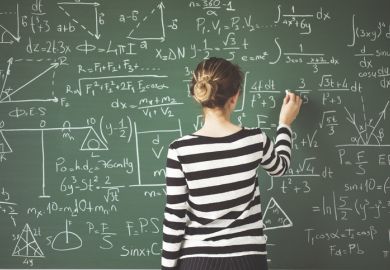When I first agreed to review this book, I misunderstood the title. It is not about an interpretation of quantum mechanics but about the interpretation of quantum mechanics. This is indeed a bold claim - but the book does live up to its promise that it is not merely "a commentary upon the writings of Bohr and Heisenberg and what they said". As has often been remarked, the existence of classical physics is "the most difficult obstacle to understanding quantum mechanics". What Roland Omnes sets out to do is to invert the usual approach to this problem. Instead of starting from the common sense of classical physics and trying to create a consistent interface with quantum mechanics, he starts with quantum mechanics. Omnes does not assume the existence of a separate, comfortable classical world but instead attempts to derive when and how common sense is valid from basic principles.
Quantum mechanics is expressed by a mathematical framework that is very alien to classical physics. The language of quantum mechanics talks about Hilbert spaces, operators, wavefunctions and probabilities: the basic problem is to relate these concepts to the macroscopic measuring devices and phenomena that make up an ordinary experiment. The results of experiments are often expressed by numbers - the position of a pointer or the value of the voltage recorded by a digital counter - or sometimes as evidence of a track of a particle in, say, a photographic emulsion or in a bubble chamber. According to Heisenberg, the physical world can be split into two parts, the observed object and the observing system. The former is described by quantum mechanics and the latter by classical physics. The choice of exactly where this "Heisenberg frontier" is located is left to us and is claimed to lead to no significant observable effects. Von Neumann, on the other hand, put forward another description of the measurement process based on treating the problem as an interaction between two quantum systems. The problem with this approach is that quantum theory predicts the existence, in principle, of bizarre interference effects involving what we prefer to think of as classical objects. It was to avoid these problems that Bohr put forward the rule that a macroscopic object is not subject to the rules of quantum mechanics but only to classical physics. Reasoning such as this left John Bell dissatisfied with quantum mechanics. He had no truck with what he called this "shifty split" of the Heisenberg frontier. Bell believed that a theory should be a theory - anything less reduced quantum mechanics to the status of a cookery book.
After beginning his book with a summary of elementary quantum mechanics, Omnes takes time to set down, more clearly than anywhere else I have seen, just what are the problems of the Copenhagen (Bohrian) view. He then outlines why an interpretation is needed to connect the mathematical formalism to the experimental facts. After clearing away the dead wood, Omnes begins to build a new bridge from quantum mechanics to the classical world. The five magic ingredients Omnes uses to construct his interpretation are treated chapter by chapter: properties, histories, logic, classical physics and decoherence. His synthesis is not entirely new - Omnes acknowledges related work by Murray Gell-Mann and Jim Hartle, and earlier work by Robert Griffiths on histories and by Wojtek Zurek on decoherence.
Omnes then applies consistent rules of logic to families of histories and gains an understanding of how classical physics emerges from quantum mechanics. Decoherence is the last piece of the jigsaw: the decoherence effect is responsible for washing out the peculiar interference effects predicted for macroscopic objects. Gell-Mann in his book The Quark and the Jaguar explains the decoherence effect as follows. It is the "entanglement" of the properties we are interested in with all the myriads of properties in which we have no interest. In a history containing the results of a sequence of horse races we are interested only in which horse wins - not what happens to the horse flies, the bits of sand, collisions with air molecules and so on. It is in the summation over all these "ignorable" details that the interference terms magically vanish and we regain classical probabilities.
What is one to make of this book? It is certainly a fascinating and serious attempt to give a pedagogical presentation of a consistent interpretation of quantum mechanics. It includes an account of all the outstanding paradoxes as well as of recent experiments. The Einstein-Podolsky-Rosen paradox, in the version put forward by David Bohm, is covered, along with Bell's inequalities, "hidden variables" and Aspect's experiments. Experiments using SQUIDs proposed by Tony Leggett show that Bohr was wrong in his assumption about the classical behaviour of macroscopic systems. The observed quantum-tunnelling behaviour of SQUIDS also provides evidence for the decoherence effect. Would the interpretation proposed by Omnes have satisfied Bell, possibly the fiercest critic of quantum mechanics? Certainly Bell was not satisfied with decoherence as an answer and I am not sure that he would have been convinced by the arguments that Omnes puts forward to rebut him. In any event, Omnes finally admits on page 504 that there remains the problem, "the existence of facts", which was "somewhat hidden behind wave packet reduction in the older interpretation" but now that most other problems have been solved or clarified, "stands pure and alone".
In conclusion, I am deeply impressed by this book and believe that anyone with a serious interest in the foundations of modern physics should read it. But for the "ordinary physicist in the street", I suspect it is not a very easy book to read, despite the liberal sprinkling of examples throughout the text. Discussions on "truth criteria" and the like make this a rather unconventional physics text. Meanwhile, like most physicists, I know quantum mechanics works "fapp" (for all practical purposes). Some day I fully intend to study the details - but just now I must get down to writing this grant proposal . . .
Tony Hey is head of the department of electronics and computer science, University of Southampton.
The Interpretation of Quantum Mechanics
Author - Roland Omnès
ISBN - 0 691 03336 6 and 03669 1
Publisher - Princeton University Press
Price - £80.00 and £29.50
Pages - 550pp
Register to continue
Why register?
- Registration is free and only takes a moment
- Once registered, you can read 3 articles a month
- Sign up for our newsletter
Subscribe
Or subscribe for unlimited access to:
- Unlimited access to news, views, insights & reviews
- Digital editions
- Digital access to THE’s university and college rankings analysis
Already registered or a current subscriber? Login



